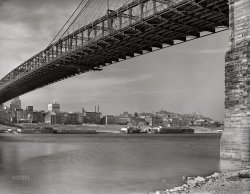
MAY CONTAIN NUTS

Search Shorpy
SHORPY ART

Framed or unframed, desk size to sofa size, printed by us in Arizona and Alabama since 2007. Explore now.
Join and Share
Ad-Free Shorpy
Shorpy is funded by you. Patreon contributors get an ad-free experience.
Learn more.

Recent comments
- Freeze Frame
- Texas Flyer wanted
- Just a Year Too Soon
- WWII -- Replacing men with women at the railroad crossing.
- Yes, Icing
- You kids drive me nuts!
- NOT An Easy Job
- I wonder
- Just add window boxes
- Icing Platform?
- Indiana Harbor Belt abides
- Freezing haze
- Corrections (for those who care)
- C&NW at Nelson
- Fallen Flags
- A dangerous job made worse
- Water Stop
- Passenger trains have right of way over freights?
- Coal
- Never ceases to amaze me.
- Still chuggin' (in model form)
- Great shot
- Westerly Breeze
- For the men, a trapeze
- Tickled
- Sense of loneliness ...
- 2 cents
- Charm City
- What an Outrage
- Brighton Park
Member Photos
The Shorpy
Print Emporium
Print Emporium
Search Shorpy
Search results -- 30 results per page
- The Privy Chamber: 1935
- December 1935. "Tenement backyard and privy, Cincinnati, Hamilton County, Ohio." 35mm nitrate negative by Carl Mydans. View full size.
Cincinnati I know you won't publish this but how dare you allow someone ... Posted by Dave - 07/25/2018 - 1:34pm -
![The Privy Chamber: 1935 December 1935. "Tenement backyard and privy, Cincinnati, Hamilton County, Ohio." 35mm nitrate negative by Carl Mydans. View full size.
CincinnatiI know you won't publish this but how dare you allow someone disparage this great city.
[All in all, I'd rather be in Cleveland. - Dave]
CincinnatiI know you won't publish this but how dare you allow someone to disparage this great city.
[But I digress. You were saying? - Dave]
CincinnatiI know you won't publish this but how dare you allow someone disparage this great city.
[Happy Groundhog Day! - Dave]
CincinnatiI know you won't publish this but how dare you allow someone to disparage our great city.
[Haven't we met before? - Dave]
CincinnatiI know you won't publish this but how dare you allow someone disparage this great city.
[It was pretty easy, actually. - Dave]
CincinnatiHow dare you allow someone to disparage our great city.
[Food for thought. - Dave]
CincinnatiI know you won't publish this but how dare you to allow someone to disparage our great city.
[I've been to Cincinnati! - Dave]
Ode to an Outhouse (author unknown)I cannot boast of my aroma
Nor do I issue a diploma.
But it's a lot of fuddy-duddy
That there's a better place to study.
FittingThat about sums up Cincinnati.
CincinnatiI know you won't publish this but how dare you allow someone to disparage our great city.
[We have extremely low standards! - Dave]
CincinnatiI know you won't publish this but how dare you allow someone to disparage our great city.
[For one thing, there doesn't seem to be a whole lot to do there. - Dave]
(The Gallery, Carl Mydans, Cincinnati Photos)](https://www.shorpy.com/files/images/SHORPY-8a00701a.thumbnail.jpg)
- Red Comb Feeds: 1943
- ... PM Pere Marquette
CCC&StL Cleveland, Columbus, Cincinnati & St. Louis "Big 4"
NYC New York Central
SL-SF St Louis-San ... Posted by Dave - 04/13/2024 - 9:40pm -
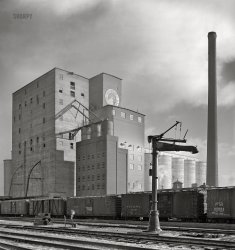
- Pier Review: 1907
- ... stage.
Tickled Is this the same Tickler as seen in Cincinnati a couple years later?
https://www.shorpy.com/node/8631
... Posted by Dave - 04/10/2024 - 1:58am -
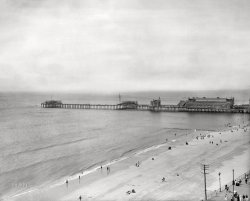
- Steam Under the Bridge: 1906
- Cincinnati, Ohio, circa 1906. The sidewheeler Cincinnati passing under the Roebling Suspension Bridge. Detroit Publishing glass negative. View full size.
City of Cincinnati The 300-foot packet steamer City of Cincinnati was built by ... Posted by Dave - 11/11/2019 - 7:30pm -
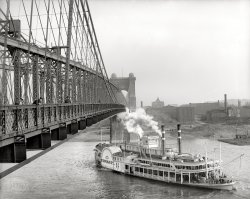
- Cothouse: 1942
- ... the night in the other.
2 in '42? BTW the Cincinnati Enquirer described "2 in '42" as a "mystery symbol." I guess it was ... Posted by Dave - 01/18/2024 - 1:39pm -
![Cothouse: 1942 November 1942. "Oklahoma City, Oklahoma. Cot house." The California Dormitory, offering not just "clean cots," but checkers and dominoes. Acetate negative by John Vachon. View full size.
SnoringIt may be a good 80 years ago and 5500 miles away, but I can still hear the snoring .
50% PremiumI wonder what extras you got for 15 cents versus the base price of a dime. A blanket? Larger size?
Heads Carolina, Tails CaliforniaI wonder how the owners/proprietors of the Largest and Most Modern Cot House in the Southwest settled upon the name "California Dormitory" as opposed to some other state dormitory? And I'd like to see the signage on nearby culinary establishments where the denizens of the Cot House got their three hots.
“California” DormitoryIt wasn’t named for the State, but rather after its location - 308 W. California Street in OKC. That part of the street no longer exists.
“California” was also the name of that specific style of dorm construction in vogue when built. I don’t know what that was/is.
The 15-cent CotMy best guess is that they gave you a second mattress to lay over the first. I don't think a cot mattress was more than an inch thick.
BTW the sign in the window refers to E.H. Moore, who was running for Senate. He won, but his health failed him and he did not run for re-election. He died in 1950.
Spelling (sigh)"Shower Bath Privilegs" - we signpainters have a proud tradition of phonetic spelling. The workmanship is quite impressive - even some flourishing around "Free" // I wonder if this was for wartime workers needing a place, or if 'Cot House' was just a standard system during the Depression?
The California Dormitorywas a style -- huge but cheap to build -- that came into being in the 1930s during New Deal employment programs. In the Adventures of Superman episode "The Ghost Wolf," Clark, Lois and Jimmy spend the night in one of these dorms. The place is so enormous that Lois doesn't think twice about staying in one end while her two colleagues spend the night in the other.
2 in '42?BTW the Cincinnati Enquirer described "2 in '42" as a "mystery symbol." I guess it was a very good mystery, since no one today seems sure about what it meant. I've scouted around a bit, and it may have meant that people should buy two war bonds during the then-current year, 1942.
[Two days' pay. - Dave]
15 centsFree WiFi.
New Orleans CotsIn about 1960 I stayed at a Cot Dormitory for a few cold nights. The price was either 25 or 50 cents a night, I forget. You raised the head of your bed up and put your shoes under the bedpost so they wouldn't be stolen.
I hitchhiked through 37 states in that period, met a lot of good people.
50% PremiumCots were 10 cents, clean cots were 15.
(The Gallery, John Vachon, OKC)](https://www.shorpy.com/files/images/SHORPY-8d09898u.thumbnail.jpg)
- The Cincinnati: 1906
- The Ohio River circa 1906. "The Cincinnati , Cincinnati, Ohio." The Louisville & Cincinnati Line sidewheeler City of Cincinnati . 8x10 inch dry plate glass ... Posted by Dave - 07/06/2022 - 4:59pm -
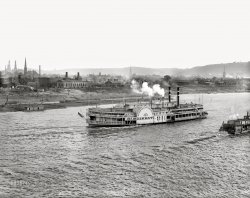
- Vacation Wagon: 1964
- ... Every August for years we travelled from Birmingham to Cincinnati for a week of visiting my parents' relatives. Before our last such ... Posted by Dave - 05/31/2022 - 1:09am -
![Vacation Wagon: 1964 Our annual salute to the start of vacation road-trip season, first posted here 15 years ago. Everyone buckled in? Let's go!
"Great Falls, Montana. Return after 3 weeks Vacation. June 27, 1964." This Kodachrome of a 1960 Chevrolet Parkwood station wagon is from a box of slides found on eBay. View full size.
family trips in those carsI also spent some hot days in a car like that on the way to the grandparents. My mother flattened the second seat, put a mattress on the floor and loaded three of us and the stuff in on top of it, us and the stuff equally loose and not tied down. We whined and fought and slept our way to Cape Cod from southern NJ. My father always "had to work" (they were her parents), so she did the drive alone, I think maybe 12 or 16 hours? Seemed like forever.
NostalgicThese people still had a bright future ahead of them, full of great hopes for the days to come. They hadn't gone to the Moon yet, and to them, by 2007 we'd have personal helicopters and robots would run everything. The possibility of the President being indicted for a crime was unthinkable. My job as a web designer hadn't even been invented yet.
The lawn looks like it's literally astroturf. Were the colors really like that, or is it an effect of the kodachrome?
Holy cow! We had a 59 chevyHoly cow! We had a 59 chevy stationwagon back in the day. Does this bring back memories. We would drive to Florida from Virginia a two day trip usually in the heat of the summer to visit grandparents. Five children two parents no ac. Damn!
[This is a 1960 Chevrolet. - Dave]
DeflectorsDoes anybody know/remember what the deflectors left and right of the rear window were for? These may have been an aftermarket item.
It is amazing how well the colors in this slide are preserved after almost 50 years. It looks like Kodachrome all right, including the telltale blue cast in the shadows
The Astroturf look......to my eye, seems to come from the little flowers (or toadstools?) that are in the lawn. At the smaller image size, they look like specular reflections, making it seem like the grass is shiny.
[The white flowers are clover. - Dave]
1964As I remember it, this was less than a year after the assassination of JFK, there were race riots in the south and we (I was 14) were all starting to question attitudes towards women, blacks, hispanics, homosexuals and the culture we had grown up with. One of the more minor cultural things was the importance of your front lawn.
50 years?I was born in 1964, and trust me, it hasn't been 50 years since then, yet.... ;)
Re:DeflectorsThe deflectors on either side of the rear window were intended to blow air across the rear window to prevent snow from accumulating. A similar deflector is often fitted along the roof on station wagons from the 60s on. I think they were usually a factory or dealer option in later years, but I really don't know specifically about this model or when they might have first been used.
OK, 40 years.Sorry, I was too vexed on the year of manufacture of the car.
I remember that someone in our street had the sedan version of this Chevy. Like any 8 year old, I was fascinated by the winged tail and the panorama windshield. You didn't see many of these in Europe around 1960; everbody, including my father, was driving Volkswagen Beetles. (He later had a new Ford Mustang 1964 1/2 , with a 289 ci V8 and a four speed box, rally pack and (optional) front discs, which I found very impressive at the time. A real gas guzzler by European standards.
Family TrucksterThis is probably what Clark Griswold's dad took the family on vacation in. It's a 1960 Chevy, and I'm guessing it's a Kingswood model. The Brookwood was the more stripped down model and I think the "full dresser" was called a Nomad. This one isn't completely chromed-out and it has the small, dog-dish hubcaps so I'm thinking it's the middle of the line model.
I think the rear air deflectors also helped keep exhaust gas from entering the rear passenger compartment when the vehicle was moving with the tailgate window was lowered. Though it doesn't look like there's room for anybody in the third row of seats for this trip. With the window up they also helped keep the rear glass clear of snow and dust.
These are Parents of the Year......in my book. Can you imagine going across country now without all of the luxuries and Wendy's and portable DVD players and Nintendo and cell phones and credit cards?
These parents did it all the HARD way...and I'll bet they made a lot of memories that summer!
My jaw droppedOnce again the red stationwagon family blows me away. The color composition here is perfect.
Chevy ParkwoodThis is a 1960 Chevrolet Parkwood. Parkwoods and Kingswoods both use Bel Air trim (mid-level). The Kingswood, a nine-passenger wagon, has the third-row rear-facing seat, and two steps on the rear bumper (one on each end just outside of where the tailgate would come down). Less obvious is that all Kingswoods have power tailgate windows, an option on the other Chevrolet wagons.
I still drive a '59 ChevyI recommend owning one. In 2000 We took the ultimate road trip with mine from near the Canadian border in Washington State through the desert to Las Vegas and back up through California and Oregon. There really is nothing like seeing the U.S.A. in your Chevrolet. Cruising the Strip in Vegas was a blast. We might as well have been driving a space ship with the reactions we got. Sadly, these Chevrolets were mostly scrapped and very few survive.
60 ChevySadly, the third row seat had not been invented as of yet and the deflectors were used to deflect air into the rear of the stationwagon at slower speeds. I may not be an expert but I'm old enough to have ridden and slept in the back section of a folded down stationwagon. We didn't know about SUV's yet.
Chevy WagonChevy's Parkwood and Kingswood wagons could both be had with a third-row seat. And back then, for the record - wagons WERE the "SUVs" of the day!
[According to the 1960 Chevrolet sales brochure, only the Kingswood was available with third-row seating. The International Travelall and Chevy Suburban Carryall were two of the SUVs of the day. - Dave]
The luggage rackis something you don't see anymore. It hung on the wall of the garage when not in use. Once my dad, who was in a big hurry, didn't secure the tarp on top properly...
We played car games, like Alphabet, Road Bingo, and License Plates, read books, colored,sang songs and squabbled. You took your chances with local restaurants. We hadn't got used to entertainment on demand, so we didn't miss it.
And to Dave Faris: It's the film. I once assured my daughter that colors when I was a kid were the same as today. "The Fifties," she said, in her narrator's voice, "were an oddly-hued decade."
Slide ConversionHow does one convert slides to digital photos? Any website links or advice?
[You'd use a film scanner. I used a Nikon 4000 ED for this one. - Dave]
Family TrucksterWe had a green Ford station wagon, not nearly as nice as this, and with our family of six, it was a masochistic experience to take family vacations. Every summer we said that's it, we will never do this again, until the following summer when we did it again. The best part was arriving home again, but I will say that NOT having DVD's and high tech electronic gadgets forced the kids to look out the window and they gained incredible geographic knowledge from seeing the U.S. I could truthfully call these annual trips "purgatory on wheels."
Road TripMost all of my long-distance car trips were connected with moving as my father was in the USAF. In August 1954, after being in the UK 2½ years, we got in our in our '53 Chevy coupe and went from New York City to the SF Bay Area, mostly along US 40. Entertainment consisted of looking at the scenery and checking off the towns on the free roadmaps that the service stations provided in each state. Iy being the pre-Interstate era, one did go thru many towns back then! (Excepting on the PA Turnpike) Burma-Shave signs relieved the boredom in the rural areas. We had a car radio (AM only, of course), but for some reason I can only recall it being used while crossing the salt flats west of Salt Lake City.
Westward HoIn 1951 our family, my wife, son and daughter, living in Detroit, started taking trips to Cheney, Washington, to visit my WW2 buddy. All on old state highways, no air conditioner, 4½ hours to get through Chicago and the kids loved it. Took these trips out west to the 1970s. We still go west to see my buddy and my daughter in Seattle and we enjoy crossing Nebraska on old U.S. 30. It is a treat to be off of I-80.
Nostalgia Ain't What it Used to BeDon't look at this picture and pine for the old days.
Change the car to a green Olds Vista Cruiser and that's us in 1969. Back then, dads bought a new station wagon to kick off the summer vacation. Dads don't buy an SUV today for that reason.
Without repeating some of the horrors already mentioned below, there was the additional joy of Mom sending back a Coca Cola bottle for one of her sons to use in lieu of a loo. If the girls had to go, we had to pull over. Not so with the boys.
Watching mom backhand-fling a Coke bottle out her window, filled with fluid far different that what was originally intended, and seeing it bounce and spill along the shoulder as we whizzed along at 75 mph (pun intended), that's about the fondest vacation memory at least from the car perspective.
Today with the daughter hooked up to a video iPod and the sons enjoying their PSP, it's a pleasure to drive for distances. Back then, we didn't play License Plates. We played Punch Buggy and Slug Bug, etc. Fistfight games.
Let's go!I loved car trips, and I never had DVD players and Nintendo. I watched the scenery and kept a travel diary. those were some of the greatest times of my life.
Road TrripWe had to make do with pillows & blankets. A mattress would have made it actually comfortable. I don't know if Dad didn't have the imagination for that, or just not the money. I suspect the latter.
We'd sing sometimes. It was 12 hours from north Georgia near the North Carolina line to south Georgia, near the Florida line, where my grandmother lived.
I see the moon; the moon sees me.
The moon sees the one that I want to see ...
Thanks for the memoriesMy folks had the four-door sedan version of this car, in sky blue & white. My mom used to have a station wagon, don't remember what kind, but it was memorable for its pushbutton transmission on the dash instead of a gearshift! However my favorite "finned" car was our family's Buick Invicta. Now that was a car!
Third Row SeatsFords had third-row seats in 1955. I'm pretty sure Chevy had them by 1958 at least. Chevy didn't offer woodgrain sides until '65.
Sunday ridesWe had that same car, only in light blue.
No seat belts or infant seats for us! We'd put my baby sister in one of those deathtrap baby seats that hooked over the front seat and off we went!
What a picture!This picture takes me back almost 40 years to the road trips our family did during summer holidays when I was a little boy. It feels like I myself am stretching my legs after coming home. The colours, the moment -- one of my favorite pictures in Shorpy.
My Favorite Car was a 1960 Chevrolet Impala 2-dr hardtop. Bluish gray with white segment on the side, red and white interior. The first car my wife and I bought. Paid $1750 for it used in 1962. We made some wonderful trips in that car.
Re: Family TrucksterJust saw this item on TV yesterday about a real family named Griswold that had their station wagon modded to look like the Family Truckster from National Lampoon's Vacation movie for their trip to Disney World.
http://tinyurl.com/plo5kub
See the USA in Your ChevroletFor our family, it was a 1962 Buick Invicta wagon. Huge car designed for doing massive mileage on the interstates and that's what we did -- six or seven hundred miles a day from Indiana to the Rockies for our annual vacation.
Procedure for Accessing the Cargo AreaWe had one of these when I was a kid as well. Ours was a silver gray color. See the chrome disk on the trunk door? Upon arriving at destination, here's what you had to do:
1) Put trunk key in center slot (separate keys for ignition and trunk back then)
2) Open flap (as seen in photo)
3) Rotate flap several times till rear window is fully down
4) Reach in and grab handle to drop tailgate
Simple, huh?
Looking at old red carsmakes my elbows hurt! Seemed like some of those old single stage paints, reds in particular, had to be waxed every two weeks to keep them looking decent. The widespread adoption of clearcoat finishes in the late 80's to mid 90's freed modern kids from the dreaded frequent waxing chore, thereby giving them the leisure time to start the video gaming revolution...
As Long AsThis isn't really the "End of the Road"! That's a scary title for all the Shorpy Faithful.
3 Adults + 7 Children =1000 mile round trip to see grandma.
We kids didn't mind a bit.
Seat belts?I don't think you heard "Everybody all buckled up?" all that much in '64. I'm not sure of the exact dates, but if you had seatbelts back then, you bought them at a discount store or an auto parts store like Western Auto or J. C. Whitney, and they were lap belts only. Three point seat belts didn't come along for several more years, if I recall correctly, and it wasn't until the government mandated new cars with ignition interlocks in the 1970's that "real men" started to actually use them.
Back then, we used to spend our vacations camping, so the car was packed to the gills, including the center of the back seat. My sister and I each got little cubbyholes next to the doors, with just room enough to sit for the trip to northern Wisconsin. My dad drove a two tone green '55 Oldsmobile Delta 88. I saw a picture of that car a few months ago, and as soon as I did, I started remembering a surprising amount of detail about the car's details. It was handed down to me when I went off to college in '64.
Seat beltsbobdog19006 is correct in that seat belts were not standard equipment in 1960. However, they had been available as a dealer-installed option since the 50s. By 1966, they were standard in all Chevys, and by 1968, they were federally mandated.
I spent many a happy hour on family roadtrips in our '68 Ford wagon, nestled in the narrow gap between the second row and the rear-facing third-row seat, no seat belt, of course. Neither did my siblings in the third row.
Service StickersI remember those stickers that service stations or car dealers put on the inside edge of the driver's door when you got your car serviced. This Chevrolet has two.
Our road trip rigWe had a '76 Chevy Beauville van, a ho-hum light brown rather than red, which made up for the lack of chrome spears with its cavernous interior: two bucket seats in front for Mom and Dad, two bench seats, and a homemade plywood bed. Strangely, all that space wasn't enough to prevent sibling quarrels.
The best story of this van was the return trip of its maiden voyage, when my uncle, who owned a small niche-market manufacturing firm, talked my dad into towing a piece of equipment from South Texas to a parking lot near Chicago, where we would deliver it to his customer from Wisconsin. We quickly got used to being asked at every single hotel, gas station, and rest stop, exactly what was the three-wheeled contraption with the hydraulically-actuated vertical roller-chain conveyor with teeth.
The looks on everyone's faces when my dad told them it was a grave-digging machine: Priceless!
Curtains?Every August for years we travelled from Birmingham to Cincinnati for a week of visiting my parents' relatives. Before our last such trip in '69, we went through a black-and-white '57 Plymouth Savoy, a metallic-beige '63 Ford Country Sedan wagon (the one without wood on the sides) and a '67 Olds VistaCruiser. I'd love to have that VistaCruiser back today. Ours was burgundy red and my dad put red stripe Tiger Paw tires on it. Imagine a 442 station wagon.
As for Shorpy's '60 Chevy wagon, I only just noticed the homemade or aftermarket side curtains, with vertical stripes of brown, gold and red to compliment the bright red car.
Thanks, Dave, for showing us this photo again... and including all the original comments, too. Great to relive all the great summer vacation stories with everyone!
Re: deflectorsIn the days before the rear window wiper on a station wagon, some folks put these on and the deflected air current would help to clean off that window to a degree. Not having either, within a mile that rear hatch would be almost impossible to see through. Been there, done that and got the tee-shirt.
This does bring back memoriesWe had a similar station wagon, but it was salmon (or was it mauve, or ecru?) colored with a white top (I think). It had a 460 a/c (four windows down while traveling sixty miles per hour, some times 560 with the rear tailgate window down). I remember taking a trip from Mississippi to Six Flags over Texas on U.S. Highway 82 (two lane most of the way) in Summer, 1964. The back seats were folded down, and the four of us kids had pillows, blankets, books, and board games to pass the time. It was replaced soon after with a 1965 Ford Country Squire Wagon with a/c, and fake wood paneling on the side. Instead of a rear facing bench seat, it had two small seats on either side that faced each each other.
Memories of summer tripsWe also lived in Montana back then, and our family truckster in the 1960s was a 1963 Rambler Classic station wagon. (Yes, I suffered greatly for it among my friends.) That's what I learned to drive, and we ranged all over the western US and Canada in it.
Before that, however, we traveled in a 1949 Studebaker Land Cruiser 4-door sedan, which my dad (both inventive and frugal) had outfitted with a set of three back seats that, when covered with the mattress from our roll-away bed, filled the back seat and trunk area with a very passable sleeping unit. That's where I spent most of my time on our travels. At other times, I would climb over the front seatback into the front bench seat between my parents. That's where I was on August 5, 1962, when we were preparing to leave Crescent City, CA, and heard on the radio that Marilyn Monroe had died.
Deflector's actual purposeWas to break the "vacuum" the "wall" that was the rear of that wagon created which would suck exhaust into the car if that rear window was open even a little bit. The fresh air, the snowless/cleaner rear window were merely bonuses...
Buckle up?A 1960 Chevy wagon probably didn't have seat belts unless the owner installed them. The kids in the back were pretty much free range as long as they didn't make too much noise. Lots of people piled the stuff on the roof and put a mattress in the back for the kids.
It was a great way to go and most of us survived.
[Seat belts were optional on all 1960 Chevrolets. - Dave]
Car playgroundMy folks had a Ford wagon of that era. No seatbelts. Folks put a mattress in the back. Became our playground on long trips. We had no desire to "sit" in a seat.
Miss station wagonsI miss station wagons. I prefer them to the SUVs that replaced them.
I also miss the bold bright colors that cars use to come in.
No SquattingLooking at all the stuff already loaded, I'm surprised the back of this wagon isn't dragging on the ground. In fact it's sitting pretty level. I wonder if dad had overload springs installed?
We've had one built for you.To BillyB: Station wagon suspensions were designed with the idea that they would have to haul some combination of eight people and their luggage, so they did OK when loaded down. They *were* softer than contemporary pickup trucks, so the back end of the station wagon wouldn't bounce all over if there were only one or two people in it. Especially at the time of this photo, gas was 25 cents a gallon and would be that price forever, so the factory didn't mind spending a little extra weight on a beefier suspension.
Also, most of the really heavy luggage went on the roof rack, which was fairly close to being in the middle of the wheelbase. The back-back, behind the rear seat, tended to contain lighter things, like blankets, pillows, the picnic basket, and - as the trip progressed - bags of souvenirs. If Dad wanted to use the inside rear-view mirror, you couldn't stack stuff much higher than the seats, anyway.
Source: I rode in the back of a '79 Oldsmobile wagon every summer from '79 to '87. I think the longest trip we took in it was from Kansas City to Washington, DC and back.
WagonsWe had a 1956 Ford wagon, then '61 Mercury wagon, finally a (I think) 1964 Ford wagon.
I remember one year with the Mercury, my mom ran low on gas. We were up in the mountains in a resort town. To get to the gas station, she had to reverse up hills, turn around for the downhills, turn around again for going up the next hill. What a ride.
Another time, 1965, we were in a typhoon in the current wagon. There were eleven of us in it. Another wild ride driving on a road along the bay. Waves washing over us, my mom hugging the middle of the road (there was an island we could not get across).
Wagons were great.
The 283 V-8with its 170 gross horsepower is not going to have much highway passing reserve with all that weight. Cross-flags over the V on the tailgate would have indicated one of several 348's which would have given more than enough reserve. That car is 58 years old but properly equipped could have kept pace with most cars on the road today in equal comfort. A 58 year old car in 1960 by comparison was barely even recognizable as such it was so rudimentary by comparison to the 1960 version in its looks and capabilities. The same comparisons held true in all other realms of life comparing 1960 to 1902--homes, conveniences, dress, you name it. Virtually any of those later areas are not that significantly different from their 1960 versions.
Those deflectors... were supposed to keep dust off the back window
Nikon CoolscanI am having a problem with mine. Can you recommend a place that can repair them.
[There aren't any. Try buying them used on eBay. - Dave]
283 V8Although I agree that a 348 engine would have been a better choice for this station wagon. The 170hp 283 was the base V8 engine with just a single two barrel carburetor. The next option up was also a 283 but with a four barrel which the above wagon may have had, which would have given it a little more passing power.
Koolscan softwareDave. What software program do you use with your 4000? As it seems the program that came with it is only works for Microsoft VISTA.
[I use the NikonScan software that came with the scanner, on a Windows 10 workstation. To install the software on a modern operating system, you have to disable Driver Signature Enforcement. And it's Coolscan, with a C. - Dave]
(The Gallery, Cars, Trucks, Buses, Kodachromes 1, Travel & Vacation)](https://www.shorpy.com/files/images/vacation_1960s_00.thumbnail.jpg)
- Nashua: 1908
- ... (the third safest city), "also tied with Cleveland and Cincinnati, Salem, Oregon, Washington, D.C. and Seattle for the most hate ... Posted by Dave - 10/20/2023 - 3:43pm -
![Nashua: 1908 1908. "Main Street -- Nashua, New Hampshire." At right, offices of the Nashua Telegraph and Fletcher's Optical Parlors. 8x10 inch glass negative, Detroit Publishing Company. View full size.
1908 and 2017
PigeonsJust try to tell me pigeons aren't trash birds!
Safe spaceMaybe you heard this already but WalletHub just named Nashua, New Hampshire, the safest city in America. The other nine in the top ten are Columbia, Maryland; South Burlington, Vermont; Gilbert, Arizona; Warwick, Rhode Island; Portland, Maine; Casper, Wyoming; Yonkers, New York; Burlington, Vermont; and Scottsdale, Arizona.
According to the same study, South Burlington, Vermont (the third safest city), "also tied with Cleveland and Cincinnati, Salem, Oregon, Washington, D.C. and Seattle for the most hate crimes per capita." Uh oh. Maybe move to Burlington, Vermont -- less than three miles away and coming in at ninth on the safest city list.
Or just stay put and take your chances.
CLOUDS!I don't know if it was luck or some type of different exposure process, but it's rare to see a sky with clouds in these old photos. The cameras couldn't pick up the subtle shades and usually the skies appear completely white even though at the time they may have been overcast or partly cloudy.
Because now you can bank onlineWorking left-to-right:
JennyPennifer's comment caused me to pay special attention to the police officer walking his beat, just to the left of the wagon parked at the curb. He's dressed like a London Bobby.
The four-story building with the curved front is, regrettably, gone. This likely happened when Main Street was straightened, and a newer bridge was built across the Nashua River. The Romanesque church at the end of the street is on the other side of the river.
The building at right, which became a bank in jrpollo's update, is now luxury condos, called The Mint. Not to criticize too much, but my first efficiency apartment had more kitchen space. I guess the residents are expected to eat out. A number of nearby restaurants have expanded their al fresco option to include both the sidewalk and the parallel parking spaces in front of their restaurant.
Straight and trueI lived in Nashua for 12 wonderful years and lived in the North End right off of Concord. This image did raise a question about the curved building a block from the river crossing. Any straightening alluded to earlier would have taken place much earlier in the 19th century...
The Sanborn Insurance maps of 1912 indicate that Main Street and the bridge were already where they are today. But the curved building, identified as the Howard Block gracefully curved to widen the main street from the width of the bridge (I am guessing). Main Street really is three lanes wide in each direction... feels like an avenue in Manhattan. I am also grateful that the Library of Congress has these Sanborn maps...! Terrific detail about buildings and their particular use.
Here is the link to that image: https://www.loc.gov/resource/g3744nm.g3744nm_g053631912/?sp=32&r=0.517,0...
Different process = CLOUDS!Eary photographic processes were primarily sensitive to only blue light. Numerous newer processes throughout the late 19th century added increases sensitivity into the greens and yellows resulting in what we now call orthochromatic materials.
It wasn't until around 1906 that a truly panchromatic emulsion with full sensitivity to red was developed. This took several decades to become dominant. It wasn't until the panchromatic films and plates became available that we begin to see photos that can render skies anything other than nearly blank white.
Orthochromatic materials remained in use for quite a while largely because you could develop them under a red safelight. Panchromatic materials required total darkness.
[Here and here, some clouds from 1864! - Dave]
Light grey/white clouds against a blue sky require a panchromatic emulsion, otherwise the clouds and sky reproduce nearly the same light grey. Only when the clouds are all grey and dark grey (think: storm clouds) will they reproduce on earlier orthchromatic or pure blue sensitive emulsions.
Tea TimeThe Grand Union Tea Company delivery wagon in the Nashua photo made me curious. My local New Hampshire grocery store used to be a Grand Union. I found a brief history of the company here:
https://oldmainartifacts.wordpress.com/2013/10/07/grand-union-tea-compan...
(The Gallery, DPC, Small Towns, Stores & Markets)](https://www.shorpy.com/files/images/SHORPY-4a22639a.thumbnail.jpg)
- Cincinnati Panorama: 1941
- ... Spring 1941. "View under Roebling Suspension Bridge of Cincinnati from Kentucky side of the Ohio River. Waterfront showing numerous business houses: Colter Grocers, Cincinnati Grain & Hay, King Bag, Queen City Rag & Paper and others." ... Posted by Dave - 12/04/2022 - 2:46pm -
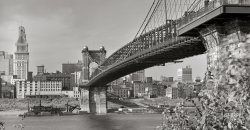
- Cincinnati: 1909
- Circa 1909. "Cincinnati from Mount Adams." Bridges over the Ohio River to Kentucky and, ... a welcome and helped German immigrants arriving in Cincinnati to find work and get settled in their new home.
(The Gallery, Boats & Bridges, Cincinnati Photos, DPC, Railroads) ... Posted by Dave - 07/29/2012 - 2:40pm -
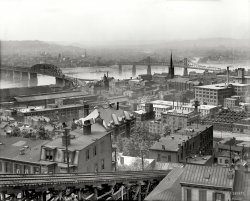
- Neighbors: 1935
- December 1935. "Hamilton County, Ohio. Cincinnati slum dwellings." 35mm negative by Carl Mydans for the Resettlement ... below is captioned "House at 1400 Block, Eastern Ave., Cincinnati." The next photo down shows the same tenement with a train behind ... Posted by Dave - 07/16/2016 - 6:44pm -
![Neighbors: 1935 December 1935. "Hamilton County, Ohio. Cincinnati slum dwellings." 35mm negative by Carl Mydans for the Resettlement Administration. View full size.
Manor on the hillInteresting comparison between the falling-down, unpainted houses at the bottom of the hill and the castle at the top.
We were so poorWe couldn't even afford a tire for the spare wheel!
Eastern Avenue, 1400 BlockJeff's comment below gives the clue that solves the mystery. The Mydans photo below is captioned "House at 1400 Block, Eastern Ave., Cincinnati." The next photo down shows the same tenement with a train behind it, plus, in the upper left, the "big house" we saw here at the top of the hill.
Workshop alfrescoThat boxy looking contraption beside the little potbellied stove is a home built table saw, for cutting wood. Most likely it ran via belt power supplies by hooking a belt to a wheel of one of the vehicles. You can see the "belt pulley" coming out the side nearest the camera, but there's no other drive mechanism visible.
Vanhorne AlleyThis was one in a series of pictures that Carl Mydans took along the now-vanished Van Horne Street (previously seen here on Shorpy -- scroll down to the comments), in what's now the Queensgate section of Cincinnati.
[In which case this may have been the area circled in red below, east of the Price Hill Incline. Click the map to enlarge. See the entire map here. - Dave]
Holy CrossThis is a view of Bucktown, a segregated and now demolished African-American neighborhood on the eastern edge of downtown. The hill in the distance is Mount Adams, and the large building is very likely the old Holy Cross Roman Catholic monastery.
[Below, the big house compared to the monastery and Immaculata Holy Cross. Doesn't look like either one. - Dave]
Not Sure Where This IsThis one has me stumped. The building on the hill looks sort of like some of the incline houses, but it doesn't match up with any of them, or with the Holy Cross monastery or the art museum. We're already starting to climb up the hill where the photographer is standing, so this isn't Van Horne Street. Based on the density and type of buildings, I would guess this is somewhere around the base of Mt. Adams or Mt. Auburn, or it could be in Mohawk/Brighton near McMicken Avenue, but I can't find a record of any buildings that look like the one on the hilltop in those areas. It could also be somewhere in Lower Price Hill or Fairmount too, with some old hospital or hotel/resort type building up top. Many of Mydans' other photos are of areas along Eastern Avenue, so this could be any one of several streets that parallel it and back up to Columbia Parkway, with a Hyde Park or Mt. Lookout mansion above.
Dave beat me to itThe other photos of the same area gave a good clue with the railroad being in the background. Interestingly, the little neighborhood off Eastern Avenue that these houses were in was completely wiped out before 1956, and not even the roads remain. The house on the hill is a mansion that was part of Edgecliff College. That was absorbed into Xavier University and much of it was demolished in the late 1980s for construction of a new high rise condo building. Because of the house's setback from the edge of the cliff (har har) we can only see the second story and the roof, but you can definitely see what it is in the aerial shot I attached.
More maps!Thanks to Jeff J. for pinpointing the location. This would be just east of Eden Park. Click below to enlarge.
ExactlyWhy I find SHORPY so interesting: the research and analysis that sorted out the location of the subjects and the mystery mansion on the hill! Well done all! Proof that coming back later is always of value with Shorpy. A great educational tool.
Source for maps?I was wondering where the Cincy map was found in hopes I could find others for my area.
[There's a link to the Rumsey Map Collection in the Vanhorne Alley comment below. - Dave]
Our Lady of CincinnatiThe big house on the hill belonged to Our Lady of Cincinnati College (later Edgecliff College). It looks a little like Emery Hall.
Edgecliff College (Our Lady of Cincinnati College)To the two folks who attached the pictures of Edgecliff (overview of the campus from Jeff and the postcard from Anonymous), can you let me know where I could obtain copies of these? I'm trying to assemble an archive of the old school. Thanks. LemminPie@aol.com
(The Gallery, Carl Mydans, Cars, Trucks, Buses, Cincinnati Photos)](https://www.shorpy.com/files/images/8a00730a.thumbnail.jpg)
- The Cincinnati Kid
- "Negro boy near Cincinnati." 1942 or 1943. View full size. Medium-format Kodachrome ... they're homespun by a loving Grandma.
(The Gallery, Cincinnati Photos, John Vachon, Kids) ... Posted by Dave - 07/21/2012 - 10:34pm -
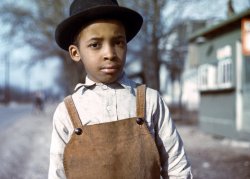
- Cincinnati: 1915
- Cincinnati, Ohio, circa 1915. "View from Mount Adams." At right, a streetcar on ... building outside New York. Not bad!
(The Gallery, Cincinnati Photos, Railroads, Streetcars) ... Posted by Dave - 08/12/2012 - 2:59pm -
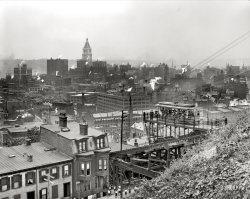
- Up the Incline: 1905
- Cincinnati, Ohio, circa 1905. "Up the hill by trolley." On one of the city's ... old McMicken Hall on the right, one of the University of Cincinnati's first buildings. While this is about a mile from campus, and that ... At first I had a bit of trouble determining which of Cincinnati's inclines I was looking at. The hill in the background was the ... Posted by Dave - 07/29/2012 - 2:40pm -
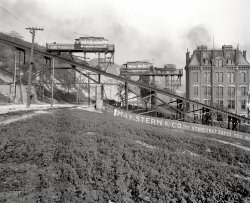
- Solid Cincinnati: 1912
- Cincinnati circa 1912. "Main Street from Fountain Square." With a nice view of ... Places.
http://thegwynnebuilding.com
PS Cincinnati is bringing back the streetcar.
(The Gallery, Cincinnati Photos, DPC, Streetcars) ... Posted by Dave - 01/29/2014 - 1:22pm -
![Solid Cincinnati: 1912 Cincinnati circa 1912. "Main Street from Fountain Square." With a nice view of the Blymyer Building. 8x10 glass negative, Detroit Publishing Co. View full size.
Maximum TractionIt looks as if the tramcar taking the curve has both its maximum traction trucks pointing the same way (pony wheel leading). Not the practice in GB where they were both either 'reversed' or 'normal'; but since this is obviously a single ended car was this a normal arrangement in the USA?
"Used extensively by U.S. Government"Well, I'm going to buy one of those Royal Typewriters, that's good enough for me.
Same Corner TodaySomehow, it doesn't look quite as lively as it did then.
View Larger Map
Goods & servicesFrom the signs alone: life insurance, drugs, tailors, paints, glass, mortgages, typewriters, printing, binding, attorneys, hats, gloves, toys, hardware, banks, clothing, dentists, drugs, restaurants, printers. Then I look at the present-day photo provided by Root 66 and all I see is insurance.
Nice To see that the Blymyer Building is still with us. And we can see where all those Royal Typewriters wound up.
[The Blymyer Building is long gone. - Dave]
The Old P.O.The building on the left, the old post office, dates to the 1880s. In the 1930s it was replaced with a new facility, now called the Potter Stewart United States Courthouse.
The buildings to the right of the streetcars have been replaced by the Wald Peck Federal Building, completed in the early 1960s.
As a stamp collector in the late '50s early '60s I would regularly visit the Philatelic Window in the newer Post Office to get the latest commemorative stamps and plate blocks of stamps that they sold.
I took my physical for the draft in the fall of 1964 in the Wald Peck building.
Gwynne BuildingThat building in the middle of the photo (a block away) is the Gwynne Building.
With large, arched windows, a peaked roof, and buff stone from the ground to the roof, The Gwynne Building is one of the most architecturally distinctive buildings in the region.
Built in 1913, the Beaux Arts style, 120,000 square foot, 13-story Gwynne Building was originally a headquarters for Procter & Gamble and is listed on U.S. Department of Interior's National Register of Historic Places.
http://thegwynnebuilding.com
PS Cincinnati is bringing back the streetcar.
(The Gallery, Cincinnati Photos, DPC, Streetcars)](https://www.shorpy.com/files/images/SHORPY_4a24860a.thumbnail.jpg)
- Harry McShane: 1908
- Harry McShane, 134 Broadway, Cincinnati. Sixteen years of age on June 29, 1908. Had his left arm pulled off ... have been 16 years old in 1908, who lived at 134 Broadway, Cincinnati. One was Henry (Harry?) in the 1900 census, father Peter. The other ... and 1910? I am going to try to get information from the Cincinnati death records to see if Henry (Harry?) died in the early 1900s. I ... Posted by Dave - 07/24/2012 - 6:59pm -
![Harry McShane: 1908 Harry McShane, 134 Broadway, Cincinnati. Sixteen years of age on June 29, 1908. Had his left arm pulled off near shoulder, and right leg broken through kneecap by being caught on belt of a machine in Spring Works factory [below] in May 1908. Had been working there more than 2 years. Was on his feet for first time after the accident the day this photo was taken. No attention was paid by employers to the boy either at hospital or home according to statement of boy's father. No compensation. View full size. Photograph and caption by Lewis Wickes Hine.
wow.wow.
HarryYeah, wow. In today's world he would've gotten a crapload of money from the employers.
failure of capitalismNow THERE is a failure of capitalism. Someone was saying the other day here that a kid working as a messenger boy was a failure of capitalism. No, this here is a failure.
Geez. I suppose there are kids we'll never see pictures of because they were killed and not merely injured.
capitalism failure?OK, well today the same thing happens, except the kids so injured are working in Red China. Is that a failure of Communism, then?
There are child workers allThere are child workers all over the world in factories, mines and other types of exploitaion exist also. And we continue to support this by buying stuff from those countries. Look at your monitor/mouse/keyboard tag. Does it read 'Made in China'?
This Harry McShane?I wonder if it's the Harry McShane that was born Dec 12, 1891 (the age would be right) and died April 1986 at the age of 94 in Dallas, TX.
Oh, I hope it's THAT Harry McShane......because it would mean he lived a long life (94!), and it was a happy one, too (got to live in Texas!).
:-)
P.S. Don't get any ideas of moving here like Harry. We're full...
Harry McShaneAfter seeing the photo on this site, I added it to my Lewis Hine Project and did some quick research. I found him in the 1910 census, and then found some other stuff. He's not the Harry McShane in Texas. He lived nearly all his life in Ohio, and he died in Ohio in 1982, at the age of 88. He got married and had at least one child. More on this later.
OK, well today the sameOK, well today the same thing happens, except the kids so injured are working in Red China. Is that a failure of Communism, then?
The Chinese gave up on Communism years ago, in all but name. They're now authoritarian capitalists. So it's just another failure of way-too-laissez-faire capitalism, to be added to the list of poisoned cat food, toys with lead paint, etc.
We used to think that democracy and capitalism were opposite sides of the same coin. No longer. It'll be mighty interesting to see what happens now.
Capitalism failure?The company I work for opened a factory in china last year. I have heard so many stories of how bad things are there for the average factory worker. We have it made here compared to the Chinese. The country is filthy and the air is dirty. The water is not suitable for drinking in many areas. We have had several employees come back sick. Be thankful for living in the USA. We need to be careful to protect what we have earned.
Horrible & sadHow sad and terrible it is to think that the employees didn't even care for the boy. I'm glad I work in a good caring company as all other companies and their employees care and watch out for each other. Good old days? I think not.
Not Capitalism, Unrestricted CapitalismIf you want an explanation of why this sort of thing doesn't happen in North America today thank unions that fought for better working conditions and legislators who pushed through laws that restricted child labour and unsafe conditions. And oh yeah, wages for workers that meant that children didn't have to go to work at 14 or younger so that the family wasn't out on the streets. It isn't a failure of capitalism; what it is is a hallmark of unrestricted capitalism.
Horrible...What a horrible tragedy. Without wading into the capitalism/communist debate, I'll just say that it is very telling that the employers wanted nothing to do with him after the accident. I wonder if he or his father ever pursued a legal course of action against the employer...
Also, after enduring such an injury in 1908, it's amazing that he is up the next month. Even today, such an injury could be fatal because of blood loss.
Ralph
sadsad, but how brave the boy was! such bravery. i want to be like him, unafraid to take a picture after such an incident. we also know the exact time the picture was taken: 2:20
Brave smileThat brave smile inclines me to think he had the resources for a happy life. I hope it was a long life, too.
Thank youFor letting us know. It's odd, but I worry about some of the people I see on here.
I know exactly how you feel, Anonymous Tipster.I thought maybe it was just because I was a history major in college or because my grandmother was Irish and sentimental, but the people I see on Shorpy often cross my mind during the day at work!
Often, it's thankfulness that the 11-14 year-olds I see are on my school campus, not working in a mine or on a loom or on an Ohio machine that could rip an arm off.
And more recently, it's been a reality check on how tough life was for my grandparents and how I'm going to come through these tough times (am currently in the middle of a divorce) just fine as long as I have my church and the love of my friends and family. Material stuff just does NOT matter if you *make up your mind* to be happy...
Isn't it wonderful how we're all connected? :-)
Fate of these peopleI sometimes wonder about the fate of some of these people in the pictures. They are/were real people with real lives, loves, happiness, and sadness. They are not just old pictures but windows into the past. It does me good to know that this man lived on and had a life after his misfortune. I love this site!
Attn: Joe Manning Re: Harry McShaneI'd just like to thank Joe for all the hard work he's putting into the Lewis Hine Project and for keeping us Shorpy viewers informed about these kids.
Harry McShaneIt looks like I spoke too soon, and the mystery deepens. This is Joe Manning again from the Lewis Hine Project. I talked to the granddaughter of the McShane who I appeared to identify as the boy in the photo. She said her grandfather had two arms and it couldn't be him. Well, it looks like she was correct. Looking further, there were two McShane boys who would have been 16 years old in 1908, who lived at 134 Broadway, Cincinnati. One was Henry (Harry?) in the 1900 census, father Peter. The other was William in the 1910 census, also father Peter. Both disappear into thin air after that. Could William and Henry (Harry?) have been the same person, or could they have been twins? If twins, could Henry (Harry?) have died between 1908 and 1910? I am going to try to get information from the Cincinnati death records to see if Henry (Harry?) died in the early 1900s. I live in Massachusetts. Anyone out there live near Cincinnati who could go to the vital records office and look it up? The search goes on.
Thanks JoeThank you we really do care
Amen to that!Thanks, Joe!
Harry McShaneThis is Joe Manning again, from the Lewis Hine Project. I finally caught up with Harry. He died in Cincinnati one month short of his 86th birthday. Despite his injuries and disability, he worked for the railroad for many years. See the details at http://www.morningsonmaplestreet.com/harrymcshane1.html
134 Broadway134 Broadway is right next to the river, now basically a parking area for the ballpark. An "underpass" as it were. Back then it was probably shantytown or tenements.
Thanks.Joe, your info is amazing. I'm glad he lived a long life.
Thanks, JoeYour research makes this website even more powerful than it would otherwise be.
Cincinnati BottomsThere's an article in today's Cincinnati Enquirer that gives some detail about the history of this area, known as the Bottoms ...
Harry McShaneThis is Joe Manning. The link to my story about Harry has been changed. It is now:
http://morningsonmaplestreet.com/2014/11/26/harry-mcshane-page-one/
(The Gallery, Cincinnati Photos, Kids, Lewis Hine)](https://www.shorpy.com/files/images/05350u.thumbnail.jpg)
- City of Angles: 1915
- Circa 1915. "Mount Adams incline, Cincinnati, Ohio." One of five "Cincinnati incline" railway elevators serving that city's hillside suburbs. ... negative. View full size.
Sadly gone All of Cincinnati's inclines are long gone. The Mount Adams was noteworthy in that it ... Posted by Dave - 04/14/2023 - 10:44am -
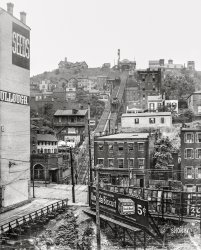
- Old New York: 1900
- ... Circa 1900. "A ferry boat, New York." The steamer Cincinnati off Manhattan. 8x10 inch dry plate glass negative, Detroit ... Hudson/North River Ferries The great picture of the "Cincinnati" on the North River in 1900 reminds me of the Ramsdell ferries ... Posted by Dave - 09/13/2011 - 6:26pm -
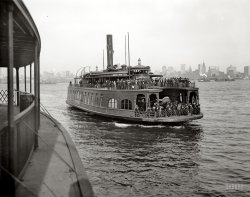
- Acorn Buggy Co.: 1909
- Circa 1909. "Cincinnati from Mount Adams." The continuation of our previous view of the ... the factory district's smoky skyline: Acorn Buggy Company, Cincinnati Bag ("Cotton, Seamless and Burlap") and of course J. Chas. ... trades.
Spilling his seed.
Did someone from Cincinnati buy the Brooklyn Bridge? Sure has a similar design.
... Posted by Dave - 08/12/2012 - 3:17pm -
![Acorn Buggy Co.: 1909 Circa 1909. "Cincinnati from Mount Adams." The continuation of our previous view of the Queen City. Among the enterprises whose names are blazoned across the factory district's smoky skyline: Acorn Buggy Company, Cincinnati Bag ("Cotton, Seamless and Burlap") and of course J. Chas. McCullough, "Seedsman." 8x10 inch dry plate glass negative, Detroit Publishing Company. View full size.
The More Things ChangeI was a bit surprised to see that a whole cluster of buildings at the left are still there today. The huge warehouse with the two water towers (Tailors L.E. Hays etc.) has had a modern makeover, and the 5th Street/Columbia Parkway Viaduct now slides in just to the right of it. The Taft Museum and its back yard, part of a small enclave of wealthy residences, can be seen poking out from the left of the warehouse. The two buildings at the very left edge of the shot remain, sans smokestack. Aerial photo. The street coming towards us is 5th, and Eggleston is running left to right behind the Seeds building and Acorn Buggy.
FechheimerFechheimer Brothers was, and apparently still is, one of the major suppliers of postal uniforms. I note their home page says they've been in Cincy since 1842, and that in addition to their foreign plants maintain three stateside union operations, presumably to cater to the union-heavy trades.
Spillinghis seed.
Did someone from Cincinnati buythe Brooklyn Bridge? Sure has a similar design.
[Cincinnati's Roebling Bridge and the Brooklyn Bridge were both designed by John Roebling. - Dave]
Memories of CincyI grew up in Cincy in the 40s and 50s in Walnut Hills, Mount Auburn, and Hyde Park. Reader Jeff mentioned Eggleston Avenue. It was near the Mt. Adams Incline which I rode many times as a kid; what a view it had at night with the open summer cars.
He also mentioned Columbia Parkway which was an early day version of an expressway. When it reached downtown, its viaduct crossed Eggleston and you could always smell the spices being made at the Frank Tea and Spice Conpany down below. Columbia then became 5th Street which went to Fountain Square and Government Square in the heart of downtown.
White HouseI believe that white house with the tree-lined triangular yard (that looks like a small park) might be the home of William Howard Taft. It is the Taft Museum, today.
Uniform tailorsWhen I was in high school we bought new band uniforms from Fechheimers. How funny that would come up after all these years!
Procter and GambleHad already been around Cincy for 70 years when this pic was made.
One more pan to the rightand just maybe we will see my favorite Cincinnati business, Lunkenheimer Valve.
More on the BridgeConcerning Chris's remark on the similarities between the Cincinnati and Brooklyn suspension bridges, they are both the product of the Roeblings (John and Washington). The Cincinnati bridge (1867) is a predecessor of the Brooklyn bridge (1883), is still in service, and currently being repaired and repainted. The deck is metal grating and "sings" when driven over. You can see the river through the deck, which is a thrill to ride a bicycle over.
http://www.roeblingbridge.com/historyb.html
(The Gallery, Boats & Bridges, Cincinnati Photos, DPC, Factories)](https://www.shorpy.com/files/images/4a19195a.thumbnail.jpg)
- On the Ohio: 1910
- ... The Ohio River circa 1910. "Nightfall on the Ohio at Cincinnati." 8x10 inch dry plate glass negative, Detroit Publishing Company. ... nor Delta Queen This is the huge sidewheeler City of Cincinnati, built in 1899 at Jeffersonville, Indiana. You are thinking of the ... Posted by Dave - 07/29/2012 - 2:42pm -
![On the Ohio: 1910 The Ohio River circa 1910. "Nightfall on the Ohio at Cincinnati." 8x10 inch dry plate glass negative, Detroit Publishing Company. View full size.
Neither the Island Queen nor Delta QueenThis is the huge sidewheeler City of Cincinnati, built in 1899 at Jeffersonville, Indiana. You are thinking of the Cincinnati, built in 1924, which was supposed to have a twin, the Louisville. The latter boat was never completed, and her hull was sold to the Coney Island Co., who finished her as the Island Queen.
Island Queen or Delta QueenI guess it could be one or the other. The Island Queen used to take passengers from the public landing in Cincy up river to the Coney Island amusement park.
I made that trip many times as a kid in the late 1940's. It was quite a thrill in the summer to sit on deck and listen to the calliope.
The Island Queen caught fire and was destroyed while in the dock at Pittsburgh in the late '40s. The Delta Queen continued to operate and as far as I know still exists.
ClassicAnd Timeless; one of the best pictures yet! Thank You!
The Delta QueenThe Delta Queen was a sternwheeler, not a sidewheeler like the boat in the Shorpy image.
The Delta Queen (below) is still used for river cruises, but not overnight trips since it doesn't meet the current safety requirements.
Far EastWith such air quality, I thought it was a picture of modern Beijing!
The past is so bright, I gotta wear shades.Absolutely, one one my all time Shorpy favorites! I love how when I gaze from bottom to top, the sun actually seems glaring.
[That's (ostensibly) the moon. One of many Detroit Publishing moonlight views. - Dave]
Moonlight?I'm going to have to differ with Dave on this. I can't imagine that there'd be a photographic emulsion fast enough in 1910 to capture that image by moonlight with no motion blur. It'd be good a trick even today. I mean, look at all the "ghosts" of pedestrians walking in broad daylight in contemporaneous street views we've seen here. Same with their other "moonlight views" in the LOC collection. My bet is that it's the equivalent of "day for night" movie filming, that for their postcards, Detroit Publishing printed it dark and tinted it bluish for a simulated moonlight effect.
Sidewheeler City of CincinnatiThe boat appears to be the 1899 sidewheeler City of Cincinnati of the Louisville & Cincinnati Packet Co., seen in previous Shorpy post: Steam Under the Bridge: 1906.
Moonlight Photography"Moonlight photography" was a discipline of some interest to shutterbugs of the late 19th and early 20th centuries. A distinction was drawn between "real moonlight photography" and "moonlight photographs" in general -- a stylistic genre that utilised underexposed pictures taken in daylight and then "printed deep" (a technique not available for this particular image, as it is taken from a negative without benefit of a paper print).
The ghostly personages who populate much of the era's daylight photography are a consequence not of slow emulsions but rather of the fact that most large view cameras of the era lacked timed shutters (what were known then as "clockwork shutters" -- most spring shutters lacked a timing mechanism and were opened and closed by the photographer, which necessitated one-Mississippi, two-Mississippi exposures of several seconds' duration), or any shutters at all, exposures being made by removing and then replacing the lens cover.
Photographers with clockwork shutters who wished to avail themselves of "fast plates" had a number of very sensitive emulsions available, as evidenced by the stop-motion photography of the 1890s. These were also utilised for "real moonlight" photographs.
[And indeed we have a number of stop-motion images here, this being one example. Although, after reading your references and tterrace's comment, I do have my doubts as to whether the nighttime photography of a century ago could freeze waves as seen in the Ohio River picture. Then again, one underestimates the capabilities of an 8x10 view camera at one's peril. - Dave]
1910 by moonlightOne of those references is to an article on "real" moonlight photography in American Photography dated 1910, the same year this shot was taken. In discussing exposures using "a long bellows reversible back view camera... exposures will range from ten to thirty minutes on a clear night using stop f8 and fast plates." It also mentions two methods of getting the moon itself in the image without showing the effect of its motion during exposure. One was to double-expose the plate, first a long exposure of the scene when the moon was out of the field of view, then a shorter one after aiming the camera at the moon. The other involved exposing two negatives when making the print, one of just the moonlit scene, the other of the moon itself.
Or the Moon Walking in BrightnessPerhaps enough sunlight and moonlight has already been shed on the subject, but a consideration of the location may further illuminate.
The boat appears to be commencing her run down river, approaching the old C&O RR bridge spanning the Ohio. The camera has taken a position a bit upriver, almost certainly the south tower of the Suspension Bridge. Both bridges align slightly to the west of due north. The point of view is roughly WNW, perhaps tending towards NWbW.
A full moon in early winter might take up position as we see, but would necessarily put cameraman and boat on river in the hour or two before dawn. A full moon in other seasons could not occupy the section of sky. The few souls visible on the boat seem dressed for heat, and -- looking far for a bit of vegetation -- the gap in the truss section of the bridge frames a bluff where trees appear in leaf.
The moon appears less likely when we find that the photograph below from Detroit Publishing bears the title Sunset on the Ohio, Cincinnati, Ohio. Many details match precisely our photo, including the distant cloud bank low on the horizon. It could easily have been taken just a short while before the boat floated into position.
On the OhioSerious contender for best picture on the blog. Any idea of the photographer?
[Mr. Detroit Publishing. - Dave]
(The Gallery, Boats & Bridges, Cincinnati Photos, DPC)](https://www.shorpy.com/files/images/4a23724a.thumbnail.jpg)
- Pop Start: 1925
- ... (KARL) MACHINE COMPANY
Karl Kiefer Machine Co. (Cincinnati, Ohio). There is a Leader in Everything - Standing Out in its Field with Spectacular Splendor of Quality and Performance. Cincinnati: The Company, 1939.
(This Item is available at the Cincinnati ... Posted by Dave - 05/17/2014 - 11:58pm -
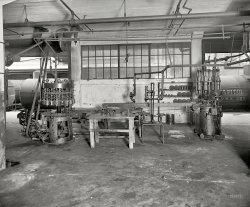
- Harry Swope: 1908
- ... Cincy A bit of Google work turned up a link to an 1889 Cincinnati Bell Telephone Book that lists a Robert J. McCombs, Grocer, at the southeast corner of Sycamore and Fourth Streets in Cincinnati. It would have been an easy walk for Harry to cross the Ohio River ... Posted by Dave - 02/16/2010 - 2:38am -
![Harry Swope: 1908 August 1908. "An Enforced Rest. Harry Swope, aged 15, 426 Elm Street, Newport, Kentucky. Carrying heavy bundles of paper for a News & Stationery company." Photo and caption by Lewis Wickes Hine. View full size.
Thank youI too visit this site almost daily. When out of town, I always look forward to seeing what's new at Shorpy when I get back home. Thank you for the many hours of entertainment I have enjoyed here.
Birthday wishes!That Shorpy have a long and happy life on the internet.
Thank you for all your work. I look forward to the variety of splendid images, full of the rich details of lives lived and experiences past.
Three CandlesAt 10:49 tonight Eastern time, Shorpy (the website, not the person) will be exactly 3 years old! Happy Valentine's Day to all.
Happy B'day Shorpy!Well done to Dave and all at Shorpy, fantastic job you do. The most educational, enlightening and entertaining site on the net.
Happy Birthday!... and thanks for all the fun.
Felicitations!May this site outlive all of us. And another thanks to Dave for running it so well; and to other contributors and tipsters, anonymous or not.
Happy birthday Shorpy!Happy birthday, Shorpy The Site, from one three-year-old to another!
[Awww. - Dave]
In the Wire Work Window... a wabbit!
Happy Birthday and THANK YOU!Thank you for providing such a wonderful website. I really enjoy "going back in time" through some of the best pictures posted on the web.
All the Best Shorpy!As far as I am concerned I have had the privilege of seeing all the best -- right here. "Happy birthday to you, happy birthday to you" etc.
Shorpy BirthdayHappy 3rd, Dave. I'm a daily visitor and never leave unhappy. We haven't, however, seen Marilyn lately ... but don't take me too seriously. Sincere best wishes and keep it coming.
Shouldn't it be "one hundred and three"?Thanks. You've changed my view of my parents' and grandparents' world. You've brought it alive for me.
Join me in a toast.I will hoist my tankard at 10:49 and say happy birthday Shorpy with thanks to Dave.
Keep Up The Good WorkHappy Valentine's Day to all of the Shorpy Staff, my compatriot readers and commenters and the ghosts of the smiling Harry Swope and the frowning Lewis Wickes Hine.
That one giant step..for lucidity. Thanks Dave for holding our feet to the fire when we post to Shorpy.(feel free to edit,you usually do).
Part-tay!Shouldn't we have one? Any excuse for cake and noisemakers! Happy Birthday, Shorpy! Thanks to all who have made this one of my favorite places to spend time.
Thanks for the MemoriesShorpy has made my retirement that much richer. Thanks, Dave and thanks all you commenters.
Two ThoughtsHappy 3rd birthday to Shorpy and young Harry sure has big feet.
Through the Wayback MachineA peek at the past - http://web.archive.org/web/20070221050736/https://www.shorpy.com/
Thanks for the hard work and excellent captions.
Happy 3rd Thanks Dave for all your hard work and for giving us a nice place to visit.
Happy Birthday Shorpy!Thanks for three years of wonderful photos and opportunities to learn about people and places of our past.
And thank you Dave, for keeping it worth coming back to again and again!
Woohoo!It's been an enjoyable 3 years and hope that there's many more.
Cheers!For the completion of 1,578,240 minutes of delightful entertainment and enlightenment. High fives and many thanks for generously sharing your labor of love.
Hot Dog!One last delivery to old man Potter.
Happy BDay, Shorpy. Keep them coming.
Make a WishHappy Birthday and thanks!
Happy Birthentines Day!This website is wonderful, and fun to check each day. Thanks for all the work you do!
A Happy Third Birthday - With Many More To ComeThere really is "Always Something Interesting" on Shorpy's. Viewing many of the high quality photographs on Shorpy's is like actually looking back through time. Keep up the excellent work.
Oh, the comments that don't get posted!Nice try, Dave, but the 400 block of Elm St. in Newport is non-commercial, residential, detached, single-family housing, and the houses there even today well predate the 1908 date on this photo. At first I thought I was wrong with my previous (unpublished) comment, but there's no way this photo was taken at 426 Elm Street in Newport. There's no commercial architecture there now, and never has been, seeing as all the houses there now are mid 19th. c. shotguns with aluminum siding tacked on.
[Hello? Try reading that caption again. 426 Elm in Newport is where Harry lives, not where the photo was taken. - Dave]
Bravo and Thank you!!Dave, Happy Birthday to Shorpy.com! This is a great time to say how much I Thank You. When I look at the photo that you posted of our buildings, and study the super-sized print we got from you, I live in 1933 for a time; I visit Tom's Lunch.
The print was in the storefront window of subject building for a while and drew and held nearly every passerby- homeless to bank exec.- who would look, and look up, and then look again... and laugh with the joy of discovery.
Thanks for that and every other treasure you bring to light.
[You're very welcome. Last year Lisa kindly took an hour out of her busy day to give me a tour of the "Tom's Lunch" building, which she owns and was renovating. Someday I will get around to posting the photos! - Dave]
Swope & ShorpyHarry Swope's a fine-looking lad, and Shorpy's the finest site on the 'net. Happy 3rd birthday!
I echo....all the sentiments here! Over the past 84 some odd weeks (since stumbling onto Shorpy) this site has become my favorite spot on the web. I can gaze for hours in amazement at the detail in the photographs and day dream about times past. Thanks Dave.
Happy 3rd and many more!Thanks for the memories and hours and hours of entertainment and education, not necessarily in that order.
Henry SwopePushing the limits of my free ancestry.com account, he was still alive as of the 1930 census, married to a Rose and still living in or near Newport, KY.
I feel a certain kinship to Harry, as we were both cursed to have that cowlick.
Oh and Happy birthday, Shorpy!
Happy 3rdThanks, Dave! This is the first place I go to when I turn on the computer.
Happy Birthday"Always something interesting"
Can't say better! I'm here every day looking for the new photos. Happy birthday, Shorpy!
Thank you, DaveShorpy is my hopeless addiction. I take breaks from my work several times a day to come here and prowl through your pages. The photos are so arresting, and I've learned a great deal from them, and from your well educated, well informed visitors. Happy birthday to Shorpys!
Thank you Dave for a great site. I discovered this site two years ago. I am addicted to it now and I check every day or several times (according to how busy work is) to see what is posted next. Thanks for helping me get thru the every day grind. I look forward to my Shorpy fix every day. Jon
Thanks Dave!Thanks Dave, for making Shorpy.com such a nice, genteel place to visit. This place is the next best thing to having a time machine.
[Thank you, and thanks everyone else. Also thanks to Shorpy co-founder Ken, who manages all things financial having to do with the website, as well as many other aspects of its operation. - Dave]
Never, never go away...A day without Shorpy is a day without sunshine. Many thanks and endless gratitude for the fascinating photos, brilliant commentary, re-awakening memories of the past and just giving us something worthwhile to look at and think about. Happy birthday Shorpy, all of us appreciate the time and hard work that goes into this pleasure for your viewers. Thanks to everyone at Shorpy, God bless us, every one.
SingularSHORPY is the only reason everyone needs a computer! Thanks, Dave. A brilliant idea carried to fruition.
Hurrah and happy birthday! Hurrah and happy birthday! Shorpy's a true gem. It's engrossing, educational, classy, just plain fun, and has one of the most civilized message boards on the 'net. Thank you Dave!
Thank you, Thank you, Thank you!!Thank you, Dave, for enabling this lover of history and photography to travel into the past each and everyday for a glimpse into history. And to all the other "tipsters", thank you as well, specially those who have posted present day shots of the many scenes presented here. The best site on the web!
Wow!Has it been three years already! Dave thank you so much and happy belated birthday to the site. One of my daily favorites.
Harry "Feet" Swope in High SchoolSeems like an accomplished young man.
http://freepages.school-alumni.rootsweb.ancestry.com/~schoolpics/KY/newp...
[Let's check our math. Harry would have been 42 years old in 1935. - Dave]
Oops! Oh well... his son seems pretty accomplished. :-)
Happy Birthday ShorpyFor most of the three years, this site has been part of my daily routine. Hardly a day goes by that I don't find at least a few minutes to stare back in time. Shorpy himself I think, would love to have known about the noteriety he'd find, a century after posing for that photo.
Thank You This Canadian agrees Shorpy.com is one of the best sites on the web . Thanks again.
Many Happy Returns to Shorpy! A great website. Thanks Dave for all your time and effort in making this work.
Happy Birthday!Not a day goes by that I don't check your site! I love it when I see shots of hometowns from times past! Keep up the good work!
Harry in CincyA bit of Google work turned up a link to an 1889 Cincinnati Bell Telephone Book that lists a Robert J. McCombs, Grocer, at the southeast corner of Sycamore and Fourth Streets in Cincinnati. It would have been an easy walk for Harry to cross the Ohio River to this location.
http://www.rootsweb.ancestry.com/~kycchgs/BOOK_M.htm
I was unable to find any information about the wirework company that probably provided the seat that Harry is using.
Harry's granddaughter says:"That would be my grandfather. His name was Henry Clay Swope. He married Rose Arizona Casebolt, and had three sons: Harry, Stanley (Bud), and Glenn (my Daddy). He was born in Newport, Kentucky, to Jacob Swope (Schwab) and Sally (Sarah) Bogart."
(The Gallery, Lewis Hine)](https://www.shorpy.com/files/images/03195u.thumbnail.jpg)
- Rookwood Pottery: 1906
- Cincinnati circa 1906. "Rookwood Pottery," noted maker of artsy mass-market ... and some ceramic decorations for homes and schools in the Cincinnati area.
The Modern Stove Polish That wall also includes a ... field A man and his scythe
Rookwood has reopened in Cincinnati They are now located in the Over-The-Rhine neighborhood: ... Posted by Dave - 08/12/2012 - 3:13pm -
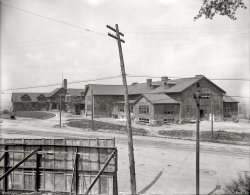
- Top Dog: 1865
- ... 1865. "City Point, Virginia. General U.S. Grant's horse Cincinnati." Wet plate glass negative, left half of stereograph pair. View ... mounts of many famous generals; Lee on Traveller, Grant on Cincinnati, Sherman rode Lexington, and Stonewall Jackson's mount was Little ... Posted by Dave - 08/09/2012 - 5:36pm -
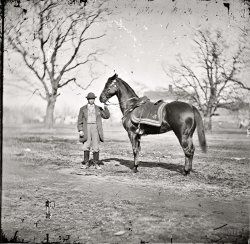
- Central Union Station: 1905
- Cincinnati, Ohio, circa 1905. "Central Union Station." You there in the window ... your desk out of the way."
That's definitely old Cincinnati. BEER HALL. All that's missing is a George Hauck or Christian ... the minutiae with reverence and glee.
(The Gallery, Cincinnati Photos, DPC, Railroads, Streetcars) ... Posted by Dave - 08/12/2012 - 3:11pm -
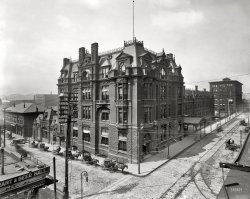
- Price Hill Incline: 1906
- "Price Hill Incline." Part of the Cincinnati streetcar and freight elevator system circa 1906. 8x10 inch glass ... never carried streetcars. It's surely sad that at one time Cincinnati had a half dozen inclines that are all gone today.
Trips ... X, 1894.
Price Hill Inclined Plane Railway of Cincinnati.
The Price Hill incline is designed for both passenger and ... Posted by Dave - 08/12/2012 - 3:06pm -
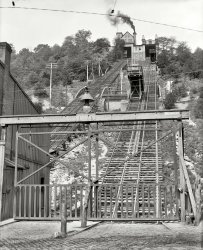
- The Underwear Railroad: 1906
- Cincinnati, Ohio, circa 1906. "Mount Adams incline." A closeup of one of ... that makes the streetcar tracks look rather far apart. The Cincinnati Street Railway used a broad track gauge of 5 feet 2 inches in those ... all?
More info There's a book covering this called "Cincinnati; City of Seven Hills and Five Inclines" including photos, drawings ... Posted by Dave - 08/12/2012 - 3:21pm -
![The Underwear Railroad: 1906 Cincinnati, Ohio, circa 1906. "Mount Adams incline." A closeup of one of Cincy's famous incline railway lines, and of a lesser-known clothesline. Also: Moxie! 8x10 inch dry plate glass negative, Detroit Publishing Company. View full size.
Mount Adams modelA fellow in Mount Adams has made a detailed model:
http://notetaker.typepad.com/incline/
And another photo showing how cars arrived at the bottom:
The foreshortening of the Shorpy photo made me question how the cars met up with the street level. The above link explains that a bit better.
I couldn't fathom the smooth rails working until I realized the two cars are linked by cable and counterbalance each other - much like elevators (used to?) do.
Also: Moxie!Dave wasn't going to let us Shorpyites overlook a Moxie sign two weeks in a row. I like Moxie.
Streetcar track gaugeIt's not only the foreshortening that makes the streetcar tracks look rather far apart. The Cincinnati Street Railway used a broad track gauge of 5 feet 2 inches in those days.
Angel's FlightLooks alot like Los Angeles.
Which came firstthe tracks, or the houses they rub right by? And can someone tell me how the cars made it up that incline? Were they towed up?
What firetraps!How all those wooden shacks were kept from all burning down I'll never know. Most were heated with stoves.
You got a lot o' Moxie palFellow Shorpsters correct me if I'm wrong but I believe the Moxie soft drink brand pre-dated CocaCola by several years at least.
That photo is vivid and transfixingEvery element of it shows the complete complexity of human endeavor and effort. Human care and attention went into every atom of that shot -- from the placement of the posters along the fences, to the cobbles in the street, to the stitches in the long drawers. Is any of it left at all?
More infoThere's a book covering this called "Cincinnati; City of Seven Hills and Five Inclines" including photos, drawings and histories of all of Cincinnati's inclined plane railroads.
Gone foreverThis was Cincinnati's last and probably most famous incline. Every once in a while someone suggests rebuilding it, since the original right of way is largely intact. Main problem: the area at the base of the incline is now a spaghetti bowl of interstate highway concrete. The track supports are still easily seen in the google satellite view.
View Larger Map
That'll stop 'emIf you look closely you'll see a pair of I-beams rising vertically out of the pavement directly between each pair of tracks. These created a simple-but-effective barrier to trolleys accidentally rolling forward into the abyss when no counterbalance platform was in the station.
The one on the left looks as if it actually did its duty a time or two.
Logistics, pleaseI still don't see how the cars met up with the street level tracks. What about that fence and what appears to be a street lamp directly in front of it? Does all that stuff fold down?
And shouldn't that little girl get out of the way?
[The "inclinator" (outlined in red) carries the car up and down. I also outlined one of its wheels. When it gets to the bottom, the streetcar is level with the street and moves onto the tracks in the foreground. - Dave]
Streetcar EscalatorThe attentive viewer will note that the sturdy railings protecting the ends of the street-mounted tracks can be lowered when the "elevator" approaches street level, as evidenced by the rollers and center thrust pillar. The conductor hooks his trolley onto the wire, and the car may roll off the inclinator and onto the street, as shown in the submitted photo.
Re: Which came first See the three cables in the middle of the track behind the car at the bottom. Those pull the car up and let it down. Most of the power comes from gravity pulling the car that is on the way down the incline. Its weight and movement help pull the upward bound car. The engine supplying any extra power needed is up in the building at the top of the hill, probably steam at that time. Both cars are basically attached to the same cables wrapping around a wheel at the top.
Moxie Lives!Moxie lives on in the far north of New England. I can't imagine why. My grandmother used to drink this stuff when I was a kid and it's vile. For extra vileness, she used to mix it 50/50 with milk.
I was shocked when I saw it for sale on a recent trip through Maine. I hadn't seen Moxie in a store for 30 years.
Up and DownMore about all five of Cincinnati's inclines here.
FunicularsIn Europe we call an inclined railway a funicular. This one had two counterbalanced platforms linked by three cables (two hosting and one safety cable). Steam engines (see the chimney) were used to power incline. There were siz I-beams, two between the tracks at the bottom station and the same at the top station and one I-beam on each platform. The normal position of all these I-beams was up. Each I-beam was counterbalanced and automatically dropped down when the platform reached the end of the track.
University of ShorpyI've learned more by visiting Shorpy than any history book I read in school. Thanks!
On Top of the InclineThis is an exceptional photo. Fascinating. My mother and her parents often took the Mount Adams incline to visit the famous Rookwood Pottery plant located on top of the incline hill. Mount Adams is still a wonderful place to visit via a walking tour. Some of these tall narrow buildings still exist alongside and in between newer structures on the Mount Adams hillside. It remains one of the cultural pockets of Cincy. For anyone interested, Rookwood Pottery relocated in 2009 from Clifton to the newly rejuvinated Over-the-Rhine historical downtown neighborhood. Cincinnati has a very active preservationist association. This city is alive with rejuvinating historical areas. Go Cincy.
Double-wire overhead"The conductor hooks his trolley onto the wire".
The conductor would place BOTH trolley poles, one on each wire. Cincinnati used a negative return wire instead of using the track, so each car had four trolley poles.
I rode the Adams Incline It closed in the 40s but I remember it well. In the summer months they would use open air cars with great views of downtown. There were several inclines in Cincy but they disappeared when buses could finally master the city's many steep hills. By 1950 all the streetcars had been replaced by buses.
Yes, Moxie!Moxie is the official soft drink of the State of Maine (as of May 10, 2005). If you're going to be in Maine in July, check out the Moxie Festival. (www.moxiefestival.com)
(The Gallery, Cincinnati Photos, DPC, Railroads, Streetcars)](https://www.shorpy.com/files/images/4a13292a.thumbnail.jpg)
- Ashcans on Van Horn: 1935
- December 1935. Hamilton County, Ohio. Vicinity of Cincinnati. Dwellings on Van Horn Street. View full size. 35mm nitrate ... sadly, I think so, Dave. This 1838 Bird's Eye Map of Cincinnati shows a Horne Street...but it likely predates Van Horn St, ... Posted by Dave - 08/12/2012 - 3:31pm -
![Ashcans on Van Horn: 1935 December 1935. Hamilton County, Ohio. Vicinity of Cincinnati. Dwellings on Van Horn Street. View full size. 35mm nitrate negative by Carl Mydans.
Judging by the graffitiAt least the gangs seem friendly...
666"666" is a medicine for colds and fever? Or a curse?
That's a very vivid picture, though. You can just imagine walking straight ahead, on down the hill.
[Cold medicine. - Dave]
Van Horn StreetYes, sadly, I think so, Dave. This 1838 Bird's Eye Map of Cincinnati shows a Horne Street...but it likely predates Van Horn St, although it's in the general vicinity of Ward 20 (the 1900 census shows Van Horn in Precinct C and D of Ward 20). [Unfortunately, while nicely drawn, the 1900 Bird's Eye Map doesn't seem to include any names for streets, businesses, or points of interest.] The current Google satellite map indicates that there's an expressway about there...and major train tracks.
It also seems that it was possibly in the amazing-looking Price Hill area. Can some locals share insights into Price Hill?
Price HillI can share a bit of insight on Price Hill. Once upon a time was a nicer area, but now it's very rough - poor, violent and rundown. It's on the lower west side of the city, close to the river - a lot of cheap historic housing to be had, if you can stomach the crime and the overall depressed feel to the town.
One of the famed "Seven Hills" in Cincinnati. Inclines were a big thing back in the day.
Price HillAT was a bit harsh on Price Hill. It's really not a poor gang infested slum that AT described. For some reason that's how too many people think of Price Hill. I'm not sure if it's learned from the media or something someone puts together in their own mind.
I'm not aware of a Van Horn St, but from the looks of the photo it could be taken from somewhere in East Price Hill. That's the part of Price Hill closest to downtown Cincinnati. If I had to guess, I would place it around Maryland Ave or near the bottom of Glenway Ave. Considering the street is so narrow and it looks like the the houses are not at street level on the left side, there are only a few places this could be. Maybe I'm not looking at the picture right?
There was a time in Cincinnati when a lot of street names were changed from their German names to more Anglo-Saxon sounding names. Not that Van Horn sounds German, but it's possible the street name no longer exists.
http://pricehillblog.com
Here's a good page of pictures of the historic Price Hill Incline.
And here are some photos I took recently from the other direction (looking down from the top of the hill, where the incline once stood).
Van Horn?I live in Cincinnati and know the town well - however, I've never heard of Van Horn, nor can I find it online. It looks similar to some alleys I've been in, but I can't seem to place any landmarks. Any idea on how I could find it?
[It's probably long gone. A lot of these old neighborhoods and streets disappeared in the slum clearance projects of the 1950s and 60s. You look where they used to be and find expressways and overpasses. - Dave]
Price HillI made the comment on Price Hill. Sure, parts of Price Hill are fine, just like any town. But having worked there (near Considine, across from the police station), I can say with assurance that my viewpoint does not come from the media.
I have to concur with previous poster - this area is quite near the large train yard - on the edge of Price Hill, and was probably swallowed up sometime in the midcentury.
Van HornIf you draw an line from Carr at Dalton Street to Baymiller at Poplar, you might have an idea of the eastern boundary of the Ward/Precinct. Ninth Street was broken up to make room for the highway long ago - you can see a remnant of it if you search for Ninth Street West (9th St W) in 45203 on the map. That would be the southern boundary of the area. I assume Van Horn made up the northern part and the RR tracks the western. What we're looking at here is an area that time forgot - west of downtown/Over the Rhine and east of Price Hill. I don't know what they call that neighborhood now but I think the freeway killed it - not much there right now but a few factories/industries.
Van Horn StreetThanks for the insights, links and pix.
Van Horn is Dutch, and there are some other Dutch named streets/alleys in that vicinity (east of Mill Creek).
The 1900 census shows Van Horn being part of the Ward 20, Precinct C boundary with Ninth, Baymiller and Carr...and part of the Ward 20, Precinct D boundary with Baymiller, Barr, RR, and Carr.
I know Ninth and Baymiller still exist...but haven't seen those others (except the railroad).
666 For Colds & FeversI collect antique bottles, tins and other items and I just so happen to have an actual labeled, corked and sealed bottle of this medicine with the original contents. Yes, it is a strange name for a medicine, but many patent medicines back then had even stranger names as well as ingredients. 666 was made in Minneapolis, MN according to the (bright red and black, no less) label on my bottle. It supposedly cured colds, fevers, ague, catarrh, rheumatism and almost any other malady one could think of. Man, I would absolutely love to have one of those advertising signs for my collection! Another excellent photograph.
~ Boone H
Van Horne AlleyVan Horne Street was in what is now Queensgate. It ran east to west between Seventh and Eighth streets and between Carr and Mound. That area is now completely industrial and there seems to be no trace left of Van Horne Street's existence. I think it was right behind the buildings put up in the 1960's on the south side of what is now West Eighth. In the Hamilton County Auditor's website, a lot of these properties make reference "Vanhorne Alley."
Map here.
Price HillCan you tell me anything about who the Considine was whose name is found in Price Hill streets, Considine Ave, Considine Lane etc? Can you say whether the lower part down by the river and east toward the railroad slot was Irish in the 1870s-1880s? email: ryan90274@yahoo.com (that stomach is scary)
(The Gallery, Carl Mydans, Cincinnati Photos)](https://www.shorpy.com/files/images/8a00715u.thumbnail.jpg)
- Along the Levee: 1904
- The Ohio River circa 1904. "Along the levee, Cincinnati." 8x10 inch dry plate glass negative, Detroit Publishing Company. ... in 1927.
When the Delta Queen used to operate out of Cincinnati, she moored at a "wharf boat," a sort of floating warehouse ... Posted by Dave - 08/12/2012 - 3:22pm -
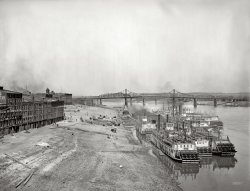
- King Bag, Queen Rag: 1941
- ... Spring 1941. "View under Roebling Suspension Bridge of Cincinnati from Kentucky side of the Ohio River. Waterfront showing numerous ... full size.
Gee?? No: G&E That would be the Cincinnati Gas and Electric building, on the left (view cut off by the bridge). ... Posted by Dave - 12/03/2022 - 4:34pm -
